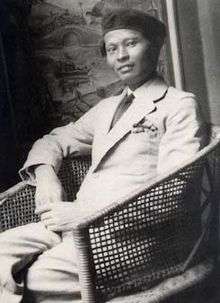Tan Ting-pho
| Tan Ting-pho | |||||||||||||||||
|---|---|---|---|---|---|---|---|---|---|---|---|---|---|---|---|---|---|
 | |||||||||||||||||
| Born |
February 2, 1895 Chiayi, Taiwan | ||||||||||||||||
| Died |
March 25, 1947 (aged 52) Chiayi, Taiwan | ||||||||||||||||
| Nationality | Taiwanese | ||||||||||||||||
| Occupation | Painter and politician | ||||||||||||||||
| |||||||||||||||||
Tan Ting-pho (Chinese: 陳澄波; pinyin: Chén Chéngbō; Pe̍h-ōe-jī: Tân Têng-pho; February 2, 1895 – March 25, 1947), was a well-known Taiwanese painter. In 1926, his oil painting Street of Chiayi was featured in the seventh Empire Art Exhibition in Japan, which was the first time a Taiwanese artist's work could be displayed at the exhibition.[1] Tan devoted his life to education and creation, and was greatly concerned about the development of humanist culture in Taiwan. He was not only devoted to the improvement of his own painting, but also to the promotion of the aesthetic education of the Taiwanese people. He was murdered as a result of the February 28 Incident, a 1947 popular uprising in Taiwan which was brutally repressed by the Kuomintang (KMT).
Early life
Tan was born into a poor family in Chiayi that could not invest in his artist talents. After attending college in Taipei, he returned to his hometown to work as a teacher, a job he held for seven years. Tan then earned enough money to attend the Tokyo University of the Arts, and graduated in 1929. Upon graduation, he moved to Shanghai for four years, where he taught art. Tan returned to Chiayi in 1933, and joined the city's Preparatory Committee to Welcome the National Government in 1945. In 1946, Tan was elected as a member of the Chiayi City Council and joined the Kuomintang.[1]
Death
Due to the February 28 Incident, severe conflict occurred in 1947 between the Chiayi citizens and the KMT, whose military was trapped inside the city's airport. The city produced a "February 28 Incident Committee", composed of Tan and five others who would approach the military as representatives of peace. The military, however, captured four of them, including Tan, and released the remaining two.[1]
On the morning of March 25, 1947, after being tied up with wire, the four were forced to march from the city's police station to the train station, where other three were shot dead in public.[1] His son, Chen Shigemitsu, recalled that as soon as hearing that his arrested father was paraded, he went onto the street and found his father on a military vehicle at Chiayi Fountain. He followed the contingent and realized what would happen when his sight suddenly met his father's.
When the vehicle stopped at Chiayi Station, the army strafed the square in front of the station, with bystanders fleeing in disorder. Tan Ting-pho was the last one pushed off the vehicle. Soldiers shot at him from three meters. The first shot missed but the second penetrated his chest, and Tan fell forward. The Kuomintang forbade the families from collecting the corpses immediately, so Tan's remains were left to decompose on the street for three days, until his wife and a photographer she had hired to take pictures of the aftermath collected them.[1]
Legacy
Tan's work Chiayi Park was sold for $5,794,100 HKD at a Hong Kong auction on April 28, 2002.[2]
In 2015, a Google Doodle commemorated his 120th birthday.[3]
References
- 1 2 3 4 5 Han, Cheung (31 January 2016). "Life and death on the streets of Chiayi". Taipei Times. Retrieved 2 February 2016.
- ↑
- ↑ "Chen Cheng-po's 120th Birthday". google.com. Retrieved 6 November 2015.
External links
| Wikimedia Commons has media related to Chen Cheng-po. |
|